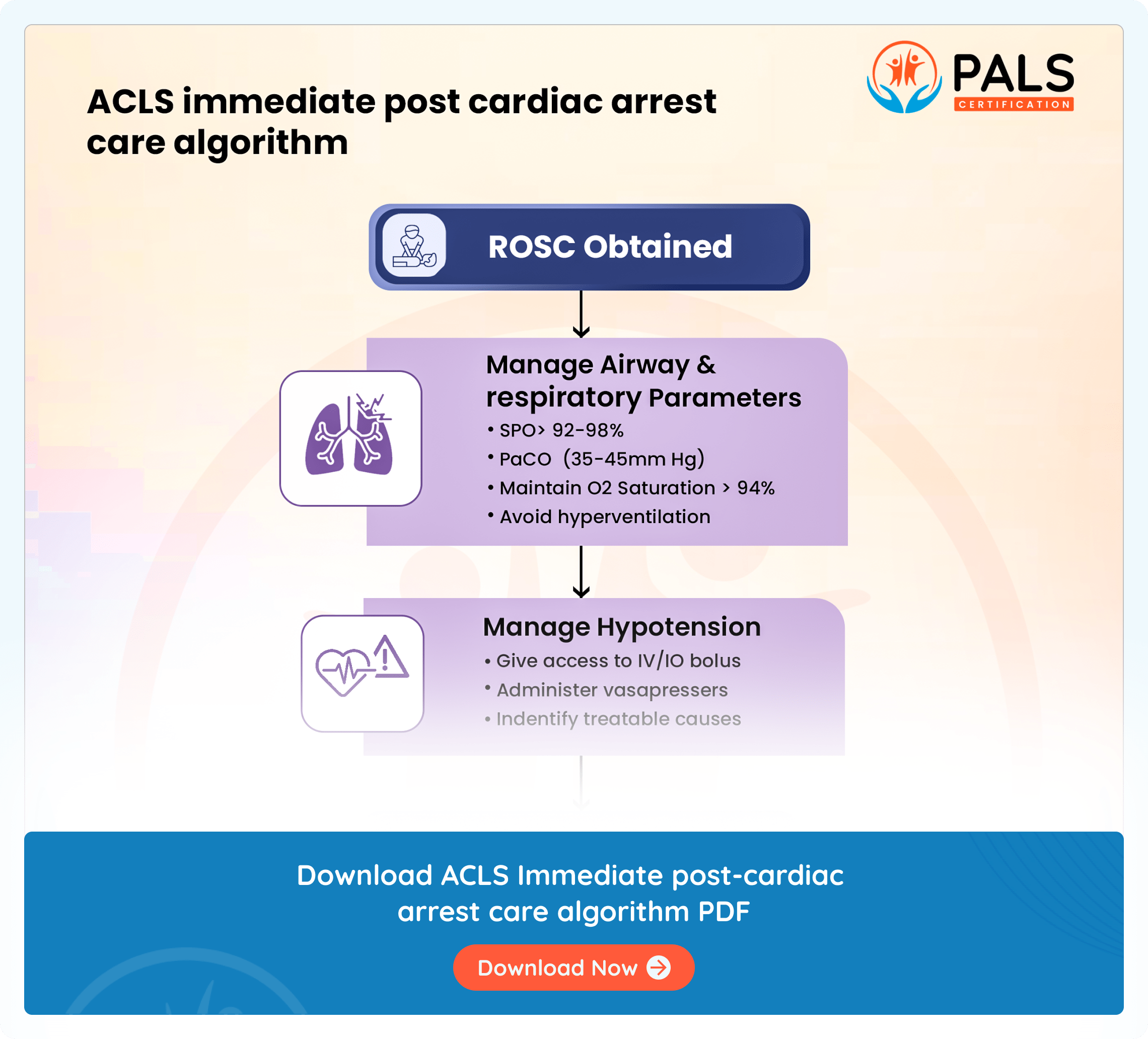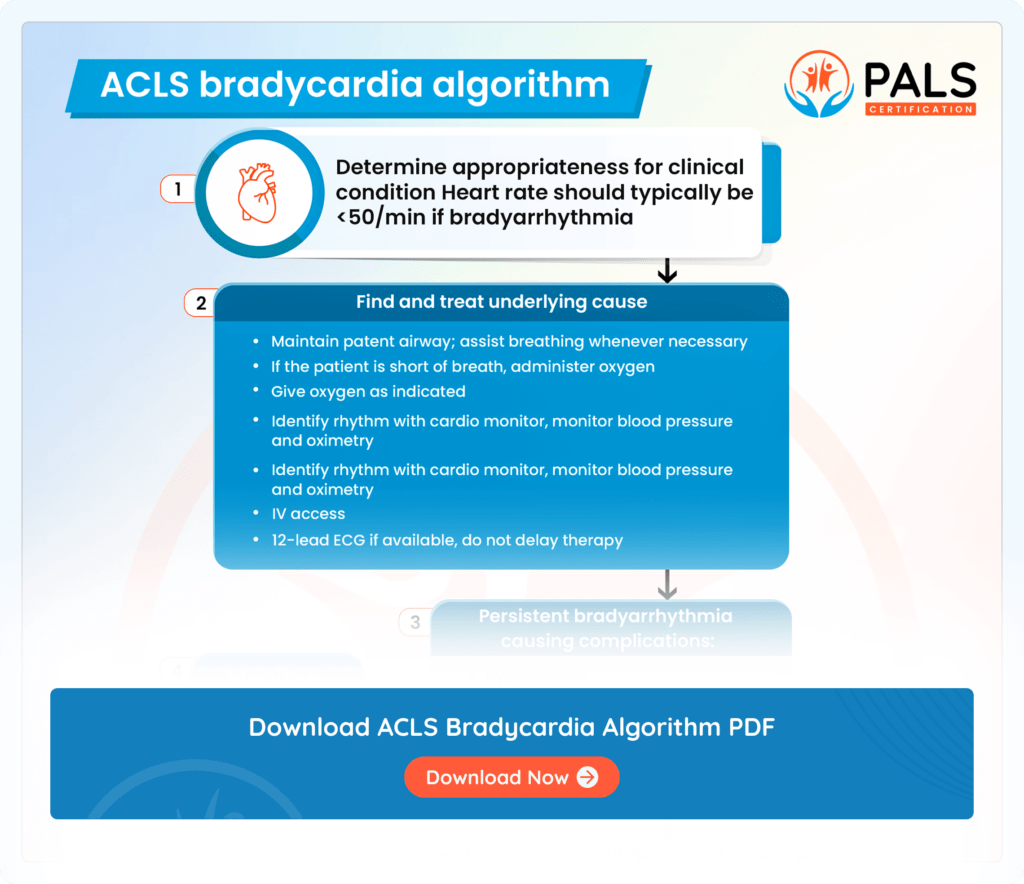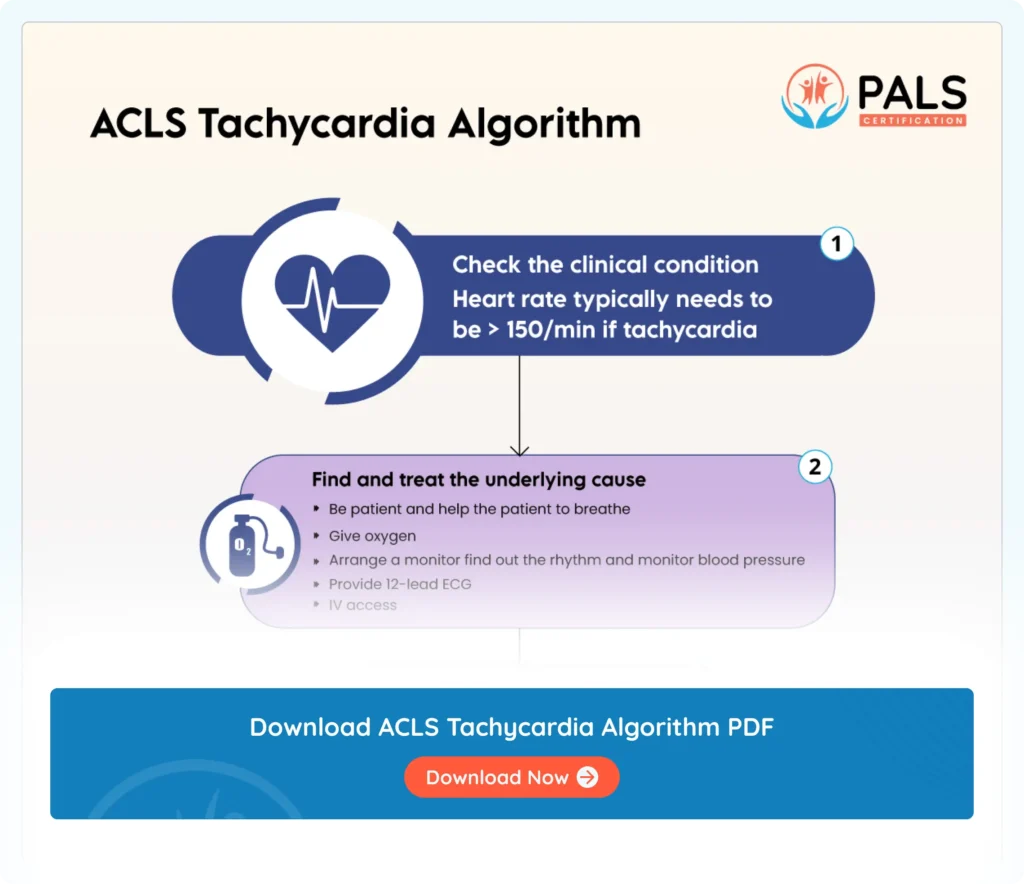- 4.0 CE Credit Hours
- For Pediatric Responders
- Includes Videos, Megacode Scenarios, Practice Tests & More
- FREE BLS Included
The ACLS post-cardiac arrest care algorithm serves as a crucial roadmap for healthcare professionals navigating patient care after successful resuscitation. It outlines a clear, step-by-step approach that combines effective CPR, defibrillation, and targeted medications, all emphasized by speedy assessment and intervention. This optimized approach maximizes the chances of return of spontaneous circulation (ROSC) and ultimately improves patient outcomes.
The accompanying flowchart delves into the details of the ACLS post-cardiac arrest care algorithm, specifically focusing on the actions taken after ROSC is achieved. Key steps include:

Online PALS certification and recertification
- Compliant with ECC and OSHA guidelines
- Nationally accepted course
- Available anytime, anywhere
- Earn CE credit hours
$119.00

Explanation of the flowchart
- ROSC Obtained
- Return of Spontaneous Circulation achieved.
- While avoiding hyperventilation, maintain SPO2 levels between 92-98%.
- Confirm and monitor advanced airway placement 10 breaths/min
- Provide ventilatory rate of 10 breaths/min
- Ensure PaCO2 remains within the range of 35-45mm Hg.
- Aim to sustain oxygen saturation levels above 94% while avoiding hyperventilation.
- Manage Hypotension:
- Ensure IV access
- Systolic Blood Pressure >90 mmHg and Mean Arterial Pressure >65 mmHg
- Identify treatable factors
- Obtain 12-lead ECG: Is the patient exhibiting a STEMI, unstable cardiac arrhythmia, or shock?
- Yes: Proceed to Coronary Reperfusion
- No: Proceed to Step 5
- If yes: Go for Coronary Reperfusion
- The patient will need to undergo a cardiac catheterization to restore blood flow to any blocked/occluded coronary arteries.
- Is the patient able to follow commands appropriately?
- No: Begin with targeted temperature management
- TTM (Targeted Temperature Management) if the patient not following commands is 32-26 degrees Celsius
- Consider CT head and EEG if the patient not following commands
- Treat reversible etiological factors and opt for Critical Care Management
Key components of PALS's Immediate post-cardiac arrest care algorithm
- Attaining ROSC: This phase signifies the restoration of Spontaneous Circulation, indicating the return of a sustained pulse and blood pressure after cardiac arrest.
- Managing Airway & Respiratory Parameters: This involves maintaining optimal oxygen saturation (SPO2) levels between 92-98% and ensuring appropriate carbon dioxide (CO2) levels (PaCO2) within 35-45mm Hg while avoiding over-ventilation to maintain saturation above 94%.
- Addressing Hypotension: This step includes establishing intravenous access, administering vasopressors to support blood pressure, and identifying and treating any reversible causes contributing to low blood pressure.
- Performing a 12-Lead ECG: Conducting a comprehensive electrocardiogram to identify signs of ST-elevation myocardial infarction (STEMI) or other cardiac abnormalities, guiding the need for immediate coronary reperfusion.
- Initiating Coronary Reperfusion: If a STEMI or acute myocardial infarction is suspected based on the 12-lead ECG findings, prompt initiation of coronary reperfusion therapy is crucial to restore blood flow to the heart.
- Responding to Commands: After achieving ROSC, it is essential to commence targeted temperature management to optimize neurological outcomes and reduce the risk of brain injury.
- Initiating Targeted Temperature Management: This involves implementing measures to regulate the patient’s body temperature within a specific therapeutic range, aimed at minimizing neurological damage and improving outcomes following cardiac arrest.
- Addressing Reversible Causes and Implementing Critical Care Measures: Identify and treat underlying factors contributing to the condition, while initiating comprehensive critical care management to optimize patient recovery.
Available Courses
PALS Certification and Recertification
ACLS Certification and Recertification
- 6.0 CE Credit Hours
- For Healthcare Professionals
- Includes Videos, Megacode Scenarios, Practice Tests & More
- FREE BLS Included
$119.00 $169.00
Get CertificateBLS Certification and Recertification
- 6.0 CE Credit Hours
- For Medical Fields
- Includes CPR & First Aid Bag-Mask Techniques
$36.95 $39.90
Get CertificateSources
- Relating oxygen partial pressure, saturation and content: the hemoglobin–oxygen dissociation curve https://www.ncbi.nlm.nih.gov/pmc/articles/PMC4666443/
- Understanding hypotension https://www.ncbi.nlm.nih.gov/books/NBK499961/
- Assessment of the 12-Lead ECG as a Screening Test for Detection of Cardiovascular Disease in Healthy General Populations of Young People (12–25 Years of Age) https://www.ahajournals.org/doi/10.1161/CIR.0000000000000025
- Reperfusion Strategies in Acute Coronary Syndromes https://www.ahajournals.org/doi/10.1161/CIRCRESAHA.114.302744
- Therapeutic temperature management (TTM): post-resuscitation care for adult cardiac arrest https://www.ncbi.nlm.nih.gov/pmc/articles/PMC5523092/
- Target temperature management in traumatic brain injury with a focus on adverse events, recognition, and prevention https://www.ncbi.nlm.nih.gov/pmc/articles/PMC9732187/#:~:text=Because%20mild%2Dto%2Dmoderate%20hypothermia,treatment%20plan%20for%20TBI%20patients
- Post-cardiac arrest care and targeted temperature management https://www.sciencedirect.com/science/article/pii/S092966462030348X
All PALS Algorithms

ACLS Bradycardia Algorithm
An ACLS Bradycardia algorithm helps you learn the guiding interventions for emergency slow heart rates

ACLS Cardiac Arrest Algorithm
The ACLS cardiac arrest algorithm directs resuscitation efforts, outlining steps like patient assessment, CPR initiation, defibrillation if needed, medication administration, reversible cause evaluation, and advanced interventions.

ACLS Tachycardia algorithms
ACLS tachycardia algorithm helps manage elevated heart rates through systematic interventions for optimal patient outcomes


